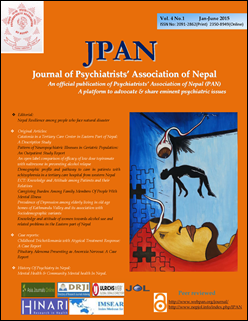ECT: Knowledge and Attitude among Patients and their Relatives
DOI:
https://doi.org/10.3126/jpan.v4i1.16740Keywords:
Knowledge & Attitude, ECT, Patient’s relativeAbstract
Introduction: There is widespread negative view of ECT in common people and other medical fraternities. Clinical efficacy of ECT does not necessarily predict patients and relatives knowledge and attitude regarding the procedure.
Materials and methods: This is a cross-sectional, retrospective study. Socio-demographic data of patients and relatives were collected. Knowledge, attitude and experience toward ECT were assessed by using an internationally validated instrument.
Results: Majority of patients and relatives replied positively that they could have refused ECT if wanted to; they received adequate information from health professionals in giving consent to ECT, therapeutic uses, processes and side effects / risks of ECT. All agreed that viewing video tapes before treatment would have been helpful. Almost all patients and relatives agreed that- ECT is not used as punishment; it does not cause permanent brain damage; ECT is not dangerous; it is given only if patients agree; patients have full autonomy about its use and it is not used to control their behavior. All patients and relatives disagreed that ECT is inhumane; it’s cruel; illegitimate; should be outlawed. All agreed that they felt satisfied with ECT and glad it was given to their relatives.
Conclusion: It is very important to give reliable and adequate information to patients and relatives about ECT. After beneficial effects of ECT and improvement in post-ECT psychopathology, subjects will have favorable attitude and increased satisfaction toward ECT. Positive experience of treatment will have enduring impact on subjects’ perceptions. Information leaflets and audio-visual aids play additional benefit when given information about the procedure.
Downloads
Downloads
Published
How to Cite
Issue
Section
License
This license enables reusers to distribute, remix, adapt, and build upon the material in any medium or format, so long as attribution is given to the creator. The license allows for commercial use.




